Darantoides is a genus of moths in the family Erebidae. The genus was erected by George Hampson in 1900.

Aedia is a genus of noctuid moths erected by Jacob Hübner in 1823. If it is placed in Catocalinae, it is assigned to its own subtribe, Aediina and if placed in Acontiinae, it is assigned to its own tribe Aediini.
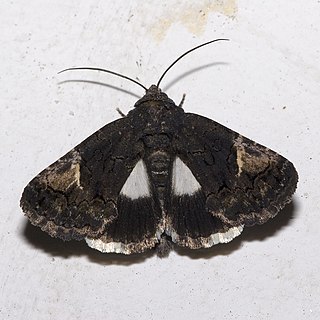
Aedia funesta or the druid is a moth of the family Erebidae. It is found in Central Europe, Southern Europe, Anatolia and Iran.
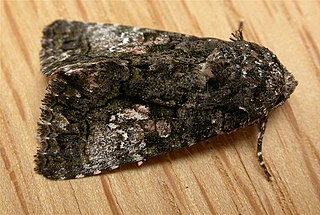
Aedia leucomelas, the eastern alchymist, sweet potato leaf worm or sorcerer, is a moth of the family Noctuidae. It is found in large parts of the world, ranging from Europe all over Asia up to Japan and some African countries. The subspecies Aedia leucomelas acronyctoides is found in Australia.

Catephia is a genus of moths of the family Erebidae. Most species of this genus are found in Africa.
Lygniodes is a genus of moths in the family Erebidae first described by Achille Guenée in 1852. The genus is restricted to the Asiatic tropics, east to Sulawesi and the Moluccas.
Meizoglossa is a monotypic moth genus of the family Noctuidae. Its only species, Meizoglossa bipunctata, was described from "Olilit, Tenimber", which seems to be an old name for a locality in the Tanimbar Islands of Indonesia. Both the genus and species were first described by Gustaaf Hulstaert in 1924.
Mesembreosa is a monotypic moth genus of the family Noctuidae. Its only species, Mesembreosa albatra, was described from "Tenimber", which appears to be an old spelling of the Tanimbar Islands in Indonesia. Both the genus and species were first described by Gustaaf Hulstaert in 1924.
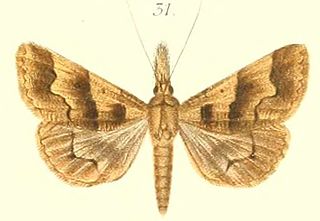
Ophyx is a genus of moths of the family Erebidae.

Polydesmiola is a genus of moths that belongs to the family Erebidae. The genus was described by Embrik Strand in 1916.

Spirama is a genus of moths in the family Erebidae first described by Achille Guenée in 1852.

Euriphene incerta, the uncertain nymph, is a butterfly in the family Nymphalidae. It is found in Sierra Leone, Ivory Coast, Ghana, Nigeria, Cameroon, the Republic of the Congo, Equatorial Guinea, the Democratic Republic of the Congo and Zambia. The habitat consists of wetter forests.
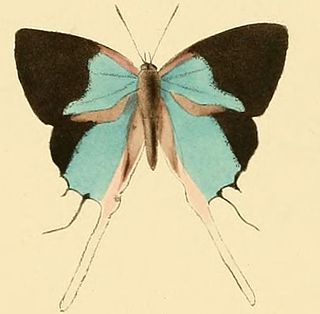
Iolaus timon, the long-tailed sapphire, is a butterfly in the family Lycaenidae. It is found in Guinea, Sierra Leone, Ivory Coast, Ghana, Togo, Nigeria, Cameroon, Gabon, the Republic of the Congo, Angola, the Democratic Republic of the Congo, Uganda and Tanzania. The habitat consists of forests.

Pentila pauli, the Paul's buff, Paul's pentila or spotted pentila, is a butterfly in the family Lycaenidae. It is found in Senegal, Guinea, Sierra Leone, Liberia, Ivory Coast, Ghana, Togo, Benin, Nigeria, Cameroon, Gabon, the Republic of the Congo, the Central African Republic, Sudan, the Democratic Republic of the Congo, Angola, Uganda, Ethiopia, Kenya, Tanzania, Zambia, Malawi and Zimbabwe. The habitat consists of deciduous woodland and forest margins.

Anthela is a genus of moths of the family Anthelidae. The genus was erected by Francis Walker in 1855.
Spirama biformis is a species of moth of the family Erebidae. It is found in Indonesia (Moluccas).
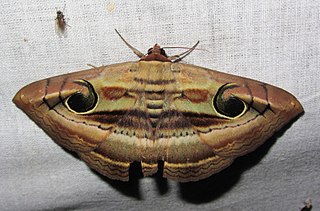
Spirama indenta is a species of moth of the family Erebidae first described by George Hampson in 1891. It is found from the Indian states of Assam and Meghalaya and from Sri Lanka to Java in Indonesia. In older texts, the species was classified as a morph of Spirama retorta.
Neoploca is a genus of moths belonging to the subfamily Thyatirinae of the Drepanidae. It was first described by Shōnen Matsumura in 1927. It contains only one species, Neoploca arctipennis, first described by Arthur Gardiner Butler in 1878, which is found in Japan, Korea, the Russian Far East and China.
Gustaaf Hulstaert (1900–1990) was a Belgian missionary who served with the Missionaries of Scheut in the Belgian Congo from 1925.
Hyperlopha cristifera is a moth of the family Noctuidae first described by Francis Walker in 1863. It is found in Sri Lanka, Laos, Malaysia and Australia. Adult wings are pale brown, sometimes with a number of dark dots near the tornus of each forewing. Forewings with a hooked wingtip, and a cusp on the margin can be found.










